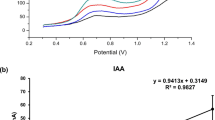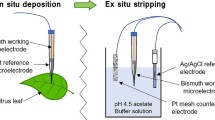Abstract
The detection of phytohormones in real time has attracted increasing attention because of their critical roles in regulating the development and signaling of plants, especially in defense against biotic stresses. Herein, stainless steel sheet electrodes modified with carbon cement were coupled with paper-based analysis devices for direct and simultaneous detection of salicylic acid (SA) and indole-3-acetic acid (IAA) in plants. We demonstrated that the excellent conductivity of stainless steel sheet electrodes enabled us to simultaneously differentiate IAA and SA at a level of 10 nM. With our approach, the content of IAA and SA in Arabidopsis thaliana leaves infected or not infected with Pst DC3000 could be rapidly quantified at the same time. Our experimental results on differentiation of IAA and SA at different time points showed that there were antagonistic interactions between the IAA and SA after infection of Arabidopsis leaves with Pst DC3000. By offering a cost-effective approach for rapid and sensitive detection of IAA and SA, this study suggests that electrochemical detection can be used in the study and development of precision agriculture technology.
Graphical abstract







Similar content being viewed by others
References
Ning YS, Liu WD, Wang GL. Balancing immunity and yield in crop plants. Trends Plant Sci. 2017;22(12):1069–79. https://doi.org/10.1016/j.tplants.2017.09.010.
Berens ML, Berry HM, Mine A, Argueso CT, Tsuda K. Evolution of hormone signaling networks in plant defense. In: leach JE, Lindow SE (eds) Annu. Rev Phytopathol. 2017;55:401–25. https://doi.org/10.1146/annurev-phyto-080516-035544.
Janda M, Ruelland E. Magical mystery tour: salicylic acid signalling. Environ Exp Bot. 2015;114:117–28. https://doi.org/10.1016/j.envexpbot.2014.07.003.
Kumar D. Salicylic acid signaling in disease resistance. Plant Sci. 2014;228:127–34. https://doi.org/10.1016/j.plantsci.2014.04.014.
Yan SP, Dong XN. Perception of the plant immune signal salicylic acid. Curr Opin Plant Biol. 2014;20:64–8. https://doi.org/10.1016/j.pbi.2014.04.006.
Jones JDG, Dangl JL. The plant immune system. Nature. 2006;444(7117):323–9. https://doi.org/10.1038/nature05286.
Spoel SH, Dong XN. How do plants achieve immunity? Defence without specialized immune cells. Nat Rev Immunol. 2012;12(2):89–100. https://doi.org/10.1038/nri3141.
Bar M, Ori N. Leaf development and morphogenesis. Development. 2014;141(22):4219–30. https://doi.org/10.1242/dev.106195.
Kazan K, Manners JM. Linking development to defense: auxin in plant-pathogen interactions. Trends Plant Sci. 2009;14(7):373–82. https://doi.org/10.1016/j.tplants.2009.04.005.
Lavy M, Estelle M. Mechanisms of auxin signaling. Development. 2016;143(18):3226–9. https://doi.org/10.1242/dev.131870.
Naseem M, Srivastava M, Tehseen M, Ahmed N. Auxin crosstalk to plant immune networks: a plant-pathogen interaction perspective. Curr Protein Pept Sci. 2015;16(5):389–94. https://doi.org/10.2174/1389203716666150330124911.
Zhao YD. Auxin biosynthesis and its role in plant development. In: Merchant S, Briggs WR, Ort D (eds) Annu Rev Plant Biol. 2010;61:49-64. https://doi.org/10.1146/annurev-arplant-042809-112308.
Zhao YD. Auxin biosynthesis: a simple two-step pathway converts tryptophan to Indole-3-acetic acid in plants. Mol Plant. 2012;5(2):334–8. https://doi.org/10.1093/mp/ssr104.
Bowling SA, Clarke JD, Liu YD, Klessig DF, Dong XN. The cpr5 mutant of Arabidopsis expresses both NPR1-dependent and NPR1-independent resistance. Plant Cell. 1997;9(9):1573–84. https://doi.org/10.1105/tpc.9.9.1573.
Clarke JD, Liu YD, Klessig DF, Dong XN. Uncoupling PR gene expression from NPR1 and bacterial resistance: characterization of the dominant Arabidopsis cpr6-1 mutant. Plant Cell. 1998;10(4):557–69. https://doi.org/10.1105/tpc.10.4.557.
Li X, Clarke JD, Zhang YL, Dong XN. Activation of an EDS1-mediated R-gene pathway in the snc1 mutant leads to constitutive, NPR1-independent pathogen resistance. Mol Plant Microbe Inter. 2001;14(10):1131–9. https://doi.org/10.1094/mpmi.2001.14.10.1131.
Abreu ME, Munne-Bosch S. Salicylic acid deficiency in NahG transgenic lines and sid2 mutants increases seed yield in the annual plant Arabidopsis thaliana. J Exp Bot. 2009;60(4):1261–71. https://doi.org/10.1093/jxb/ern363.
Wang D, Pajerowska-Mukhtar K, Culler AH, Dong XN. Salicylic acid inhibits pathogen growth in plants through repression of the auxin signaling pathway. Curr Biol. 2007;17(20):1784–90. https://doi.org/10.1016/j.cub.2007.09.025.
Du FY, Ruan GH, Liu HW. Analytical methods for tracing plant hormones. Anal Bioanal Chem. 2012;403(1):55–74. https://doi.org/10.1007/s00216-011-5623-x.
Sun LJ, Xie Y, Yan YF, Yang HB, Gu HY, Bao N. Paper-based analytical devices for direct electrochemical detection of free IAA and SA in plant samples with the weight of several milligrams. Sens. Actuators B Chem. 2017;247:336–42. https://doi.org/10.1016/j.snb.2017.03.025.
Sun LJ, Zhou JJ, Pan JL, Liang YY, Fang ZJ, Xie Y, et al. Electrochemical mapping of indole-3-acetic acid and salicylic acid in whole pea seedlings under normal conditions and salinity. Sens. Actuators B Chem. 2018;276:545–51. https://doi.org/10.1016/j.snb.2018.08.152.
Kitte SA, Li SP, Nsabimana A, Gao WY, Lai JP, Liu ZY, et al. Stainless steel electrode for simultaneous stripping analysis of cd(II), Pb(II), cu(II) and hg(II). Talanta. 2019;191:485–90. https://doi.org/10.1016/j.talanta.2018.08.066.
Huo DD, Li DD, Xu SZ, Tang YJ, Xie XQ, Li DY, et al. Disposable stainless-steel wire-based electrochemical microsensor for in vivo continuous monitoring of hydrogen peroxide in vein of tomato leaf. Biosensors-Basel. 2022;12(1). https://doi.org/10.3390/bios12010035.
Lo KH, Shek CH, Lai JKL. Recent developments in stainless steels. Mater Sci Eng R Rep. 2009;65(4-6):39–104. https://doi.org/10.1016/j.mser.2009.03.001.
Hedberg Y, Karlsson ME, Blomberg E, Wallinder IO, Hedberg J. Correlation between surface physicochemical properties and the release of iron from stainless steel AISI 304 in biological media. Colloids Surf B Biointerfaces. 2014;122:216–22. https://doi.org/10.1016/j.colsurfb.2014.06.066.
Rezaei B, Havakeshian E, Ensafi AA. Decoration of nanoporous stainless steel with nanostructured gold via galvanic replacement reaction and its application for electrochemical determination of dopamine. Sens. Actuators B Chem. 2015;213:484–92. https://doi.org/10.1016/j.snb.2015.02.106.
Rezaei B, Shams-Ghahfarokhi L, Havakeshian E, Ensafi AA. An electrochemical biosensor based on nanoporous stainless steel modified by gold and palladium nanoparticles for simultaneous determination of levodopa and uric acid. Talanta. 2016;158:42–50. https://doi.org/10.1016/j.talanta.2016.04.061.
Huo XL, Qi JF, He KC, Bao N, Shi CG. Stainless steel sheets as the substrate of disposable electrochemical sensors for analysis of heavy metals or biomolecules. Anal Chim Acta. 2020;1124:32–9. https://doi.org/10.1016/j.aca.2020.05.018.
Suzuki M, Yamazaki C, Mitsui M, Kakei Y, Mitani Y, Nakamura A, et al. Transcriptional feedback regulation of YUCCA genes in response to auxin levels in Arabidopsis. Plant Cell Rep. 2015;34(8):1343–52. https://doi.org/10.1007/s00299-015-1791-z.
Seguel A, Jelenska J, Herrera-Vasquez A, Marr SK, Joyce MB, Gagesch KR, et al. PROHIBITIN3 forms complexes with ISOCHORISMATE SYNTHASE1 to regulate stress-induced salicylic acid biosynthesis in Arabidopsis. Plant Physiol. 2018;176(3):2515–31. https://doi.org/10.1104/pp.17.00941.
Huang PX, Dong Z, Guo PR, Zhang X, Qiu YP, Li BS, et al. Salicylic acid suppresses apical hook formation via NPR1-mediated repression of EIN3 and EIL1 in Arabidopsis. Plant Cell. 2020;32(3):612–29. https://doi.org/10.1105/tpc.19.00658.
Livak KJ, Schmittgen TD. Analysis of relative gene expression data using real-time quantitative PCR and the 2(T)(-Delta Delta C) method. Methods. 2001;25(4):402–8. https://doi.org/10.1006/meth.2001.1262.
Zhang GF, Zhao F, Chen YQ, Pan Y, Sun LJ, Bao N, et al. Jasmonate-mediated wound signalling promotes plant regeneration. Nature Plants. 2019;5(5):491–7. https://doi.org/10.1038/s41477-019-0408-x.
Sun LJ, Pan ZQ, Xie J, Liu XJ, Sun FT, Song FM, et al. Electrocatalytic activity of salicylic acid on au@Fe3O4 nanocomposites modified electrode and its detection in tomato leaves infected with Botrytis cinerea. J Electroanal Chem. 2013;706:127–32. https://doi.org/10.1016/j.jelechem.2013.07.038.
Sun LJ, Feng QM, Yan YF, Pan ZQ, Li XH, Song FM, et al. Paper-based electroanalytical devices for in situ determination of salicylic acid in living tomato leaves. Biosens Bioelectron. 2014;60:154–60. https://doi.org/10.1016/j.bios.2014.04.021.
Sun LJ, Liu XJ, Gao L, Lu YN, Li YB, Pan ZQ, et al. Simultaneous electrochemical determination of Indole-3-acetic acid and salicylic acid in pea roots using a multiwalled carbon nanotube modified electrode. Anal Lett. 2015;48(10):1578–92. https://doi.org/10.1080/00032719.2014.991963.
Wang HR, Bi XM, Fang ZJ, Yang HB, Gu HY, Sun LJ, et al. Real time sensing of salicylic acid in infected tomato leaves using carbon tape electrodes modified with handed pencil trace. Sens Actuators B Chem. 2019;286:104–10. https://doi.org/10.1016/j.snb.2019.01.119.
Wang Z, Ai F, Xu Q, Yang Q, Yu JH, Huang WH, et al. Electrocatalytic activity of salicylic acid on the platinum nanoparticles modified electrode by electrochemical deposition. Colloids Surf B Biointerfaces. 2010;76(1):370–4. https://doi.org/10.1016/j.colsurfb.2009.10.038.
Wang Z, Wei F, Liu SY, Xu Q, Huang JY, Dong XY, et al. Electrocatalytic oxidation of phytohormone salicylic acid at copper nanoparticles-modified gold electrode and its detection in oilseed rape infected with fungal pathogen Sclerotinia sclerotiorum. Talanta. 2010;80(3):1277–81. https://doi.org/10.1016/j.talanta.2009.09.023.
Gan T, Hu CG, Chen ZL, Hu SS. A disposable electrochemical sensor for the determination of indole-3-acetic acid based on poly(safranine T)-reduced graphene oxide nanocomposite. Talanta. 2011;85(1):310–6. https://doi.org/10.1016/j.talanta.2011.03.070.
Acknowledgements
This work was supported by the National Natural Science Foundation of China (Nos: 31770399, 21974012 and 32070397), the Natural Science Foundation of Jiangsu Province (Nos: BK20130389), the project of Nantong Natural Science Foundation (MS22021038), Qing Lan Project of Jiangsu Province, Six talent peaks project in Jiangsu Province (No: SWYY-061), and the science and technology innovation project of Jiangsu Province (202110304080Y).
Author information
Authors and Affiliations
Contributions
Conceptualization, Lijun Sun and Ning Bao; Methodology, Ling Sun, Songzhi Xu, and Yihui Tang; Validation, Yihui Tang; Formal analysis, Ling Sun, Yuhang Zhou and Meng Wang; Investigation, Xinyu Zhu; Data curation, Guangxi Li and Yuhang Zhou; Writing-original draft preparation, Ling Sun, Songzhi Xu and Lijun Sun; Writing-review and editing, Songzhi Xu, Lijun Sun and Ning Bao; Visualization, Xinyu Zhu and Yiran Tian; Supervision and project administration, Lijun Sun; Funding acquisition, Lijun Sun. All authors have read and agreed to the published version of the manuscript.
Corresponding authors
Ethics declarations
Conflicts of interest
The authors declare no conflict of interest.
Additional information
Publisher’s note
Springer Nature remains neutral with regard to jurisdictional claims in published maps and institutional affiliations.
Rights and permissions
Springer Nature or its licensor holds exclusive rights to this article under a publishing agreement with the author(s) or other rightsholder(s); author self-archiving of the accepted manuscript version of this article is solely governed by the terms of such publishing agreement and applicable law.
About this article
Cite this article
Sun, L., Xu, S., Tang, Y. et al. Disposable stainless steel working electrodes for sensitive and simultaneous detection of indole-3-acetic acid and salicylic acid in Arabidopsis thaliana leaves under biotic stresses. Anal Bioanal Chem 414, 7721–7730 (2022). https://doi.org/10.1007/s00216-022-04303-0
Received:
Revised:
Accepted:
Published:
Issue Date:
DOI: https://doi.org/10.1007/s00216-022-04303-0




